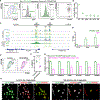The TFAP2C-Regulated OCT4 Naive Enhancer Is Involved in Human Germline Formation
- PMID: 30590035
- PMCID: PMC6342560
- DOI: 10.1016/j.celrep.2018.12.011
The TFAP2C-Regulated OCT4 Naive Enhancer Is Involved in Human Germline Formation
Abstract
Human primordial germ cells (hPGCs) are the first embryonic progenitors in the germ cell lineage, yet the molecular mechanisms required for hPGC formation are not well characterized. To identify regulatory regions in hPGC development, we used the assay for transposase-accessible chromatin using sequencing (ATAC-seq) to systematically characterize regions of open chromatin in hPGCs and hPGC-like cells (hPGCLCs) differentiated from human embryonic stem cells (hESCs). We discovered regions of open chromatin unique to hPGCs and hPGCLCs that significantly overlap with TFAP2C-bound enhancers identified in the naive ground state of pluripotency. Using CRISPR/Cas9, we show that deleting the TFAP2C-bound naive enhancer at the OCT4 locus (also called POU5F1) results in impaired OCT4 expression and a negative effect on hPGCLC identity.
Keywords: OCT4; PGC; PGCLC; TFAP2C; enhancer; naive; pluripotency.
Copyright © 2018 The Author(s). Published by Elsevier Inc. All rights reserved.
Conflict of interest statement
DECLARATION OF INTERESTS
The authors declare no competing interests.
Figures





References
Publication types
MeSH terms
Substances
Grants and funding
LinkOut - more resources
Full Text Sources
Molecular Biology Databases
Research Materials

